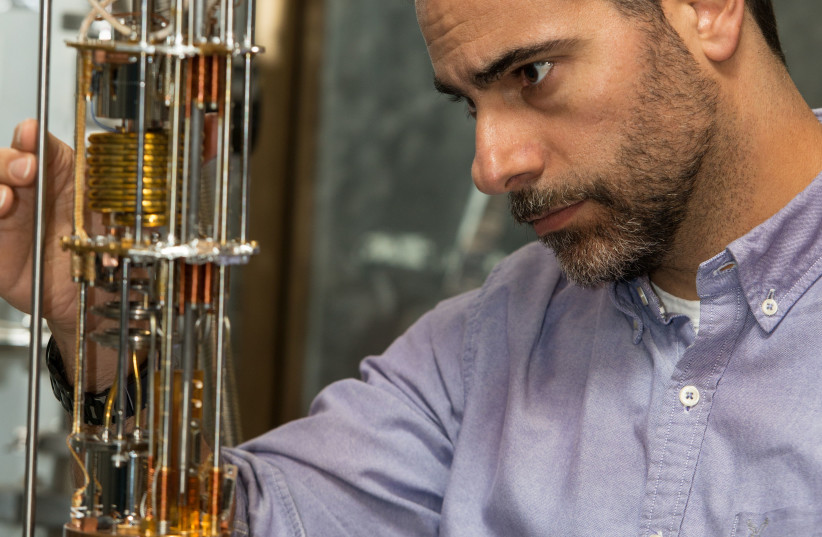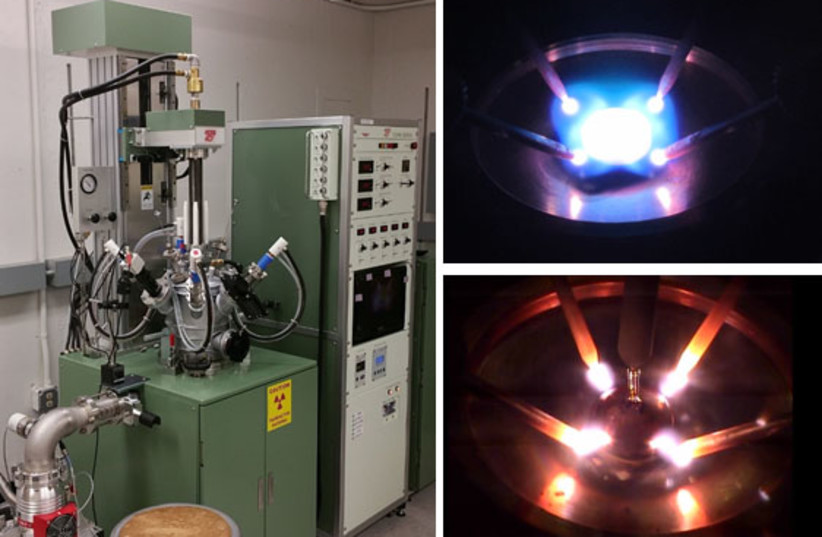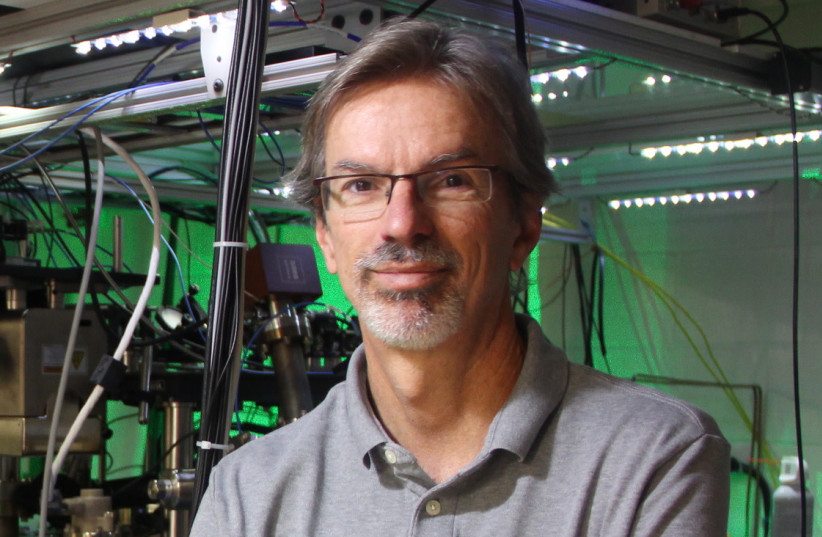“It is almost impossible to overstate what a quantum computer will be able to do,” Christopher Monroe told the Magazine in a recent interview.
Monroe – a professor at both the University of Maryland and Duke University, as well as co-founder of the quantum computing company IonQ – discussed how quantum computing will change the face of the planet, even if this might take some more time.
The Magazine also interviewed four other experts in the quantum field and visited seven of their labs at the University of Maryland.
These labs – the full likes of which do not yet exist in Israel – hosted all kinds of qubits (the basis of quantum computers), lasers blasting targets to cause plasma to come off to form distinctive “films,” infrared lasers, furnaces reaching 2,000ºC, a tetra arc furnace for growing silicon crystals, special dilution refrigerators to achieve cryostorage (deep freezing) and a variety of vacuum chambers that would seem like an alternate reality to the uninitiated.
Before entering each lab, there needed to be a conversation about whether this reporter should be wearing the special goggles that were handed out to avoid getting blinded.


One top quantum official at Maryland, Prof. Dr. Johnpierre Paglione, assured the Magazine that the ultrahazardous materials warning on many of the lab doors was not a concern at that moment.
From cracking the Internet as we know it, to military and economic dominance, to changing the way people manage their lives, quantum computers are predicted to make mincemeat of today’s supercomputers. Put simply, they are made out of and operate from a completely different kind of material and set of principles connected to qubits and quantum mechanics, with computing potential that dwarfs classical computers’ capabilities.
Often the race for the first quantum computer is phrased as a competition between the US and China. Canada, the EU countries, Israel and others are framed as trying to finish as close behind as possible or working to create applications for using the new computers the juggernauts will build.
But let’s say the US wins the race – who in the US would win it? Would it be giants like Google, Microsoft, Amazon, IBM and Honeywell? Or might it be a lean and fast solely quantum-focused challenger like Monroe’s IonQ?
At first glance, Google has no real challenger. In 2019, Google said it achieved quantum supremacy when its quantum computer became the first to perform a calculation that would be practically impossible for a classical machine, by checking the outputs from a quantum random-number generator.
The search-engine giant has already built a 54-qubit computer whereas IonQ’s largest quantum computer only has 32 qubits. Google has also promised to achieve the holy grail of quantum computing, a system large enough to revolutionize the Internet, military and economic issues, by 2029. Although China recently reproduced Google’s experiment, Google is still regarded as ahead of the game.
Why is a 32-qubit quantum computer better than a 54-qubit one?
So why is Monroe so confident that his company will finish the race long before Google?
First, he takes a shot at the Google 2019 experiment.
“It was a fairly academic exercise. The problem they attacked was one of those rare problems where you can prove something and you can prove the super computer cannot do it. Quantum mechanics works. It is not a surprise. The problem Google tackled was utterly useless. The system was not flexible enough to program to hit other problems. So a big company did a big academic demonstration,” he said with a sort of “whoop-dee-do” tone and expression on his face.
“Google had to repeat its experiment millions of times… The signal went down by orders of magnitude. There are special issues to get the data. There are general problems where it cannot maintain [coherence].” The Google experiment and qubits “decayed by seven times the constant. We gauge on one time for the constant and we can do 100 operations,” with IonQ’s quantum computers.
In radioactive decay, the time constant is related to the decay constant and essentially represents the average lifetime of a decaying system, such as an atom. Some of the tactics for potentially overcoming decay go back to the lasers, vacuum chambers and cryostorage refrigerators mentioned above.
Monroe said from a business perspective, the experiment was a “big distraction, and you will hear this from Google computer employees. They had to run simulations to prove how hard it would be” to do what they were doing with old computers “instead of building better quantum computers and solving useful algorithms.
“We believe quantum computers work – now it is time to build them,” he stressed.
Describing IonQ’s quantum computers, Monroe said, “The 32-qubit computer is fifth generation. The third and fourth generation is available to [clients of] Microsoft, Amazon and Google Cloud. It is 11 qubits, which is admittedly small, but it still runs more than any IBM machine can run. An 11-qubit computer is very clean operationally. It can run 100 or so ops [operations] before the laser noise causes coherence to be lost [before the qubits stop working]. That is many more ops [operations] than superconductors. If [a computer] has one million qubits, but can only run a few ops [operations], it is boring. But trapped ions adding more qubits at the same time makes things cheaper.”
He added, “The 32-qubit computer is not yet on the cloud. We are working in private with customers’ financials,” noting that a future publication will discuss “the baby version of an algorithm” which could be very “interesting when you start to scale it up. Maybe in the next generation, we can engineer it to solve an optimization problem – something we don’t get from the cloud, where we don’t get any telemetry,” which would be an unusual benefit for clients.
According to Monroe, that he will be able to build a 1,000-qubit computer by 2025 – practically tomorrow in the sphere of new inventions – will in and of itself be game-changing. This is true even if it is not yet capable of accomplishing all the extreme miracles that much larger quantum computers may someday accomplish.
Regarding the Jewish state, he said, “There are lots of collaborations with Israel. We have a hotshot post-doc from Israel who is supposed to go back and run a Iontrap group,” after education at Israel’s top science institutions and experience in the military.
Error correction
A major innovation or risk (depending on your worldview) by Monroe is how he treats the paramount challenge of quantum computers and error correction – basically the idea that for quantum computers to work, some process must be conceived to prevent qubits from decaying at the rate they currently decay at – otherwise crucial calculations get interrupted mid-calculation.
Here, Monroe critiques both the Google approach and responds to criticism from some of his academic colleagues about his approach to error correction. “Google is trying to get to one million qubits that do not work well together.”
In contrast, a special encoding process could allow IonQ to create what Monroe called a single sort of “super qubit,” which would eliminate “99.9% of native errors. This is the easiest way to get better” at quantum computing, as opposed to the quantity over quality path Google is pursuing.
But he has to defend himself from others poking holes in his approach as unrealistic, including some of his colleagues at University of Maryland (all sides still express great respect for each other). Confronted by this criticism, he responded that their path of attack was based on “the theory of error correction. It implies that you will do indefinitely long computations, [but] no one will ever need this” high a standard to do business.
“We do not use error correction on our CPU [central processing unit] because silicon is so stable. We call it OK if it fails in one year,” since that is more than enough time to be economically worthwhile. Instead of trying to eliminate errors, his strategy is to gradually add more qubits, which achieves slightly more substantial results. His goal is to work around the error-correction problem.
Part of the difference between Monroe and his academic colleagues relates to his having crossed over into a mix of business and academia. Monroe’s view on this issue? “Industry and academia do not always see things the same way. Academics are trained to prove everything we do. But if a computer works better to solve a certain problem, we do not need to prove it.”
For example, if a quantum computer doubled the value of a financial portfolio compared to a super computer’s financial recommendations, the client is thrilled even if no one knows how.
He said that when shortcuts solve problems and certain things “cannot be proven but where quantum computing finds value – academics hate it. They are trained to be pessimists. I do believe quantum computers will find narrow applications within five years.”
Which qubits should operate quantum computers?
Besides error correction, another question is what the qubits themselves, the basis of different kinds of quantum computers, should be made out of. The technique that many of his competitors are using to make computers out of a particular kind of qubit has the benefit of being not hard to do, inexpensive and representing beautiful physics.
However, he warned, “No one knows where to find it if it exists… So stay in solid-state physics and build computers out of solid-state systems. Google, Amazon and others are all invested in solid-state computers. But I don’t see it happening without fundamental physics breakthroughs. If you want to build and engineer a device… if you want to have a business… you should not be reliant on physics breakthroughs.”
Instead of the path of his competitors, Monroe emphasized working with natural quantum atoms and tricking and engineering them to act how he wants using low pressure instead of low temperatures.
“I work with charged atoms or ions. We levitate them inside a vacuum chamber – which is getting smaller every year. We have a silicon chip. Just electrodes, electric force fields are holding up these atoms. There are no solids and no air” in the vacuum chamber, which means the atoms “remain ‘extremely well isolated.’ They are the most perfect atoms we know, so we can scale without worrying about the top of the noise [the threshold where qubits decay]. We can pick qubit levels that do not yet decay.
“Why are Google and IBM investing in natural qubits? Because they have a blind spot. They have been first in solid-state physics and engineering for 50 years. If there is a silicon solid-state quantum computer, Intel will make that, but I don’t see how it will be scaled,” he declared.
MONROE IS far from the full quantum show at Maryland.
Paglione has been a professor at University of Maryland for 13 years and the director of the Maryland Quantum Materials Center for the last five years.


In 1986, the center was working on high-temperature superconductors, Paglione said, noting that work on quantum computers is a more recent development. The development has not merely altered the focus of the center’s research. According to Paglione, it has also helped grow the center from around seven staff members 30 years ago to around 100 staff members when all of the affiliate members, students and administrative staff are taken into account.
Similarly, Dr. Gretchen Campbell, director of the Joint Quantum Institute, told the Magazine that a big part of her institution’s role and her personal role has been to first bring together “people from atomic physics and condensed-matter physics – even within physics, we do not always talk to each other,” followed by connecting these experts with computer science experts.
Campbell explained it was crucial to explore the interaction between the quantum realm and quantum algorithms, for which they needed “more math and computer science backgrounds” and to continue to move “from laboratories to real-world applications… to translating into technology and interacting more with industry.”
She also guided the Magazine, adorning goggles, through a lab with a digital micromirror device and laser beams relating to atom clouds and light projectors.
Add in some additional departments at Maryland as well as a partnership with the National Institute of Standards and Technology (NIST) and the number of staff swells way past 100. What are their many different teams working on? The lab studies and experiments are as varied as the different disciplines, with Paglione talking about possibilities for making “squid devices” or sensitive magnetic sensors that could be constructed by using a superconducting quantum interference device.
Paglione said magnetometer systems could be used with “squids” to sense the magnetic field of samples. These could be used as detectors in water. If they were made sensitive enough, they could sense changes in a magnetic field, such as when a submarine passes by and generates a changed magnetic field.
This has drawn attention from the US Department of Defense.


A multidisciplinary mix of Paglione’s team recently captured the most direct evidence to date of a quantum quirk, which permits particles to tunnel through a barrier as if it is not even there. The upshot could be assisting engineers in designing more uniform components to build both future quantum computers and quantum sensors (reported applications could detect not only submarines but aircraft).
Paglione’s team, headed by Ichiro Takeuchi, a professor of materials science and engineering at Maryland, successfully carried out a new experiment in which they observed Klein tunneling. In the quantum world, tunneling enables particles, such as electrons, to pass through a barrier even if they lack sufficient energy to actually climb over it. A taller barrier usually makes climbing over harder and fewer particles are able to cross through. The phenomenon, known as Klein tunneling, happens when the barrier becomes completely transparent and opens up a portal that particles can traverse regardless of the barrier’s height.
Scientists and engineers from Maryland’s Center for Nanophysics and Advanced Materials, the Joint Quantum Institute and the Condensed Matter Theory Center along with the Department of Materials Science and Engineering and Department of Physics, succeeded in making the most compelling measurements of the phenomenon to date.
Given that Klein tunneling was initially predicted to occur in the world of high-energy quantum particles moving close to the speed of light, observing the effect was viewed as impossible. That was until scientists revealed that some of the rules governing fast-moving quantum particles can also apply to the comparatively sluggish particles traveling near the surface of some highly unusual materials.
It was a “piece of serendipity” that the unusual material and an elemental relative of sorts shared the same crystal structure, said Paglione. “However, the multidisciplinary team we have was one of the keys to this success. Having experts on topological physics, thin-film synthesis, spectroscopy and theoretical understanding really got us to this point.”
Bringing this back to quantum computing, the idea is that interactions between superconductors and other materials are central ingredients in some quantum computer architectures and precision-sensing devices. Yet, there has always been a problem that the junction, or crossover spot, where they interact is slightly different. Takeuchi said this led to sucking up countless amounts of time and energy tuning and calibrating to reach the best performance.
Takeuchi said Klein tunneling could eliminate this variability, which has played havoc with device-to-device interactions.


AN ENTIRELY separate quantum application could be physics department chairman Prof. Steve Rolston’s work on establishing a quantum communications network. Rolston explained that when a pair of photons are quantum entangled you can achieve quantum encryption over a communications network, by using entangled particles to create secure keys that cannot be hacked. There are varying paths to achieve such a quantum network and Rolston is skeptical of others in the field who could be seen as cutting corners.
He also is underwhelmed by China’s achievements in this area. According to Rolston, no one has figured out how to extend a secure quantum network over any space sizable enough to make the network usable and marketable in practical terms.
Rather, he said existing quantum networks are either limited to very small spaces, or to extend their range they must employ gimmicks that usually impair how secure they are. Because of these limitations, Rolston went as far as to say that his view is that the US National Security Agency views the issue as a distraction.
In terms of export trade barriers or issues with China, he said he opposes controls and believes cooperation in the quantum realm should continue, especially since all of his center’s research is made public anyway.
Rolston also lives up to Monroe’s framing of the difference between academics and industry-focused people. He said that even Monroe would have to admit that no one is close to the true holy grail of quantum computers – computers with a massive number of qubits – and that the IonQ founder is “banking on interesting optimization problems” being solvable for industry to an extent which will justify the hype instead.
In contrast, Rolston remained pessimistic that such smaller quantum computers would achieve sufficient superiority at optimization issues in business to justify a rushed prediction that transforming the world is just around the corner.
In Rolston’s view, the longer, more patient and steadier path is the one that will eventually reap rewards.
For the moment, we do not know whether Google or IonQ, or those like Monroe or Rolston will eventually be able to declare they were right. We do know that whoever is right – and whoever is first – will radically change the world as we know it.
This is the second article in a series on quantum computing (the first appeared on January 29).

